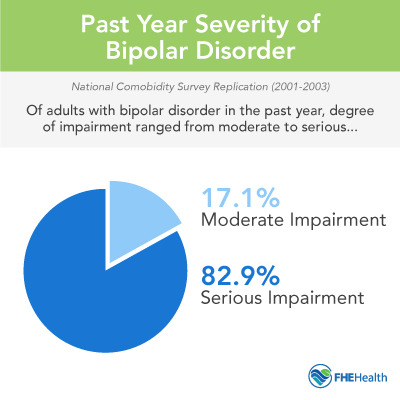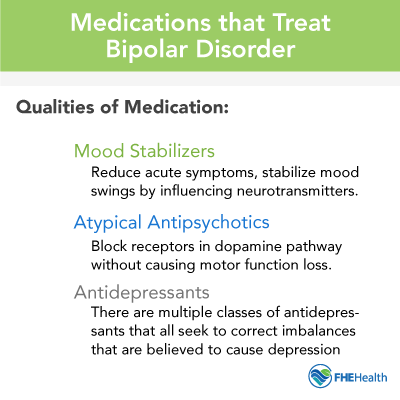What Is Bipolar Disorder?
Bipolar disorder is a condition of the brain that affects just under 3 percent of Americans, according to the National Institute of Mental Health (NIMH). It’s also called manic-depressive illness or manic depression. Bipolar disorder causes extreme changes in mood that often lead to shifts in energy and activity levels. These changes can have a debilitating impact on sufferers’ everyday activities and self-confidence.
The highs and lows of bipolar disorder are referred to as episodes. They are classified into three types.
- A manic episode is a period of elation when a person experiences dramatically increased energy levels and an unusually high mood.
- Less severe manic episodes are called hypomanic.
- Depressive episodes, by contrast, create feelings of overwhelming sadness and hopelessness.
Bipolar Disorder vs. Everyday Mood Swings
Even non-bipolar people can suffer from hypomanic or depressive moments, or mood swings, but those with the condition will experience these cycles regularly. FHE has the experience and expertise to find the best treatment for any variant of this disorder.

How Is It Diagnosed?
 FHE’s qualified staff can diagnose bipolar disorder once physical conditions are ruled out. The process involves taking a detailed history and taking into account any conditions that can mimic bipolar symptoms.
FHE’s qualified staff can diagnose bipolar disorder once physical conditions are ruled out. The process involves taking a detailed history and taking into account any conditions that can mimic bipolar symptoms.
Once we’ve made the diagnosis, we’ll evaluate the frequency and duration of episodes to determine which of the four major classifications of bipolar disorder the client is dealing with. That determination makes it possible for us to offer the right treatment options.
What Is Unipolar Bipolar Disorder?
Unipolar bipolar disorder refers to the depression within the bipolar disorder. Where someone with bipolar disorder experiences two mood states, mania and depression, someone with unipolar bipolar disorder primarily experiences the depressive state.
Symptoms of unipolar depression commonly present as:
- Sadness or irritability
- Changes in appetite and weight
- Loss of interest in previously enjoyable activities
- Changes to sleeping patterns
While bipolar disorder affects approximately 2.8% of Americans, it’s estimated that 6.0% of American adults had a depressive episode in 2020.
Understanding Bipolar Disorder: Bipolar 1 vs Bipolar 2
Within bipolar disorder, there are two classifications: bipolar 1 and bipolar 2. Understanding the differences between these two types of bipolar disorder allows you to better understand the emotions you or your loved one is dealing with.
Understanding Bipolar 1
Bipolar 1 differs from bipolar 2 disorder in that the individual never has to experience a depressive episode to receive the diagnosis. They simply need to exhibit one episode of mania within their lifetime. According to a 2005 study, between 25% and 33% of people with bipolar disorder in non-treatment samples say they’ve never had a major depressive episode.
Manic episodes in bipolar 1 are extreme, sometimes requiring hospitalization for the patient’s own safety. These manic episodes must last seven days or longer continuously (all day, every day) to be classified as bipolar mania.
Understanding Bipolar 2
Bipolar 2 is less extreme than bipolar 1 from an outside perspective, but to the individual experiencing it, there are still emotional highs and lows that are challenging to navigate. People with bipolar 2 experience episodes of hypomania, which are less intense mood elevations.
Often, people with bipolar 2 have longer-lasting depression than people with bipolar 1. A bipolar 2 diagnosis requires a major depressive episode lasting at least two weeks and at least one episode of hypomania. The highs in bipolar 2 may not even impair a person’s function, instead making them more productive.
Understanding bipolar disorder 2 requires knowledge of the severity of the depression that accompanies the condition. A 2010 study found that people with bipolar 2 and bipolar 1 were at similar risks for suicide attempts but that people with bipolar 2 were more likely to use violent, lethal methods.
Other Types of Bipolar Disorder
Cyclothymic Disorder (Cyclothymia)
For sufferers of this variant, hypomania and depression persist for too long to be clinically considered “episodes.” The low and high mood swings aren’t as severe as other bipolar variants.
Other Disorders, Specified, Unspecified and Related
Symptoms that don’t match the previous three bipolar disorder types fall into this category.
It’s also important to note that bipolar disorder often co-occurs with other physical and mental conditions. Anxiety, eating disorders, attention deficit hyperactivity disorder, and substance abuse issues are common. Some physical conditions are more frequent in bipolar patients as well, including diabetes, migraines, obesity and thyroid disease. FHE plans an individualized course of treatment for the particular circumstances of every patient.
Identifying Signs and Symptoms
If you’re concerned that you or a loved one may be suffering from bipolar disorder, there are symptoms you can watch for. Manic and depressive episodes are the most obvious symptoms. Because it’s normal for everyone to experience highs and lows, the severity of symptoms is important. When evaluating potential manic and depressive episodes, these are levels that may support a diagnosis:
Manic Episodes
- Unusually high energy levels
- Engaging in reckless behavior
- Dramatically increased activity levels
- Racing thoughts
- Insomnia
- Feeling agitated
- Feeling irritable
- Rapid speech about scattered subjects
- Feelings of elation
- Restlessness
- Overconfidence in abilities
Depressive Episodes
- Lowered energy levels
- Reduced activity levels
- Feelings of sadness and hopelessness
- Insomnia or oversleeping
- Lack of enthusiasm for previously enjoyable activities
- Obsessive worrying
- Difficulty concentrating
- Abnormal eating (too little or too much)
- Forgetfulness
- Feelings of exhaustion
- Thoughts of suicide or death
If you or a loved one experiences these symptoms at regular intervals, it may be time to contact professionals like those at FHE and get evaluated. Early diagnosis and treatment are the keys to living a fulfilling and satisfying life with bipolar disorder.
 There are several
There are several 







